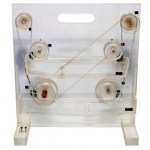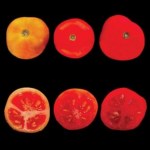
Here's another article we came across while editing material on the still-theoretical new website. Unfortunately, the article is more about the photographer than Anna Weizmann, herself.
Prof. Anna Weizmann was Chaim's younger sister, (there were a dozen brothers and sisters, all of them chemists, engineers and doctors). She was also one of the original 11 scientists (3 of whom were women) at what was then the Daniel Sieff Research Institute (est. 1934). She never married, (one article she co-authored referred to her as Miss Anna Weizmann) and she ran Dr. Chaim Weizmann's lab after his…
We are still frustrated in our efforts to get our new website up and running, so here's something dated to contemplate. Going through the old articles that are in the process of being transferred over, here's one that popped up from the second issue of Interface magazine (1992): Library without Walls. The article extols the new intranet services available to Weizmann Institute users:
Over the past year, notes Chief Librarian Ms. Ilana Pollack, several databases acquired by the Institute Library System have been hooked via optical readers and computer servers into the Institute's…
We don't mean to kvetch, but the new website we promised back in June is still as elusive as cold fusion. Scientific research, of course, is going strong, and we even continue to write about it, but no one can read about it on our website (and therefore, we can't offer links to articles on the newest findings).
In the meantime, here is the October image from our 2010-2011 calendar:
It looks like quite a simple apparatus, but in many ways, it was far ahead of its time. It was called a mechanochemical engine, and it was created at the Institute in the 1950s by Prof. Aharon Katzir. Katzir…
Feel the need to eat chocolate when under pressure? You might be able to blame it on your genes, specifically a gene in the brain that responds to stress. This gene, when active, brings out your anxiety and as well as bringing about metabolic changes that tell your body to burn sugar, rather than fat. The same metabolic changes reduce insulin sensitivity in muscles, raising sugar levels in the blood, and causing the pancreas to churn out more insulin. According to the Institute scientists who revealed the gene's function, if the constant stress of daily life keeps this gene overworked, the…
Thousands came to the Weizmann Institute yesterday evening for Researchers' Night activities. Researcher's Night is sponsored by the EU, and it takes place all over Israel and across Europe. In addition to lab tours and showings of 3-D films of molecular structures, the Clore Garden Science -- an outdoor science museum on the Weizmann campus -- swarmed with activity. Especially popular were the fire juggler, hands-on educational activities in the EcoSphere, and the telescopes set up especially for the event.
Israel's Minister of Science and Technology gets a lesson in physics
Atop the…
The Jewish holiday season is upon us, and that means lots of days off and not many new science articles. In fact, we have a stockpile of science stories waiting for our new website, but glitches and the need for a Hebrew site have been holding things up. In the meantime, here is a video from the Animix international comics, animation and caricature festival held in August in Tel Aviv, which featured Nano Comics workshops for kids with scientists and various Israeli comics illustrators.
The Nano Comics, themselves, will appear on the new website, should it ever go live.
Coming up, at the end…
It goes without saying that questions are the basis of scientific research. But all too often, especially in the PR department, we focus on the findings and forget about the process that led to those findings. So it was a refreshing change for us to put out an annual report on the theme of questions.
While the report takes as its premise the "big", even somewhat rhetorical questions, many of the featured scientists relate to the driving questions that keep them in the lab from morning to night.
In his message, Institute President Prof. Daniel Zajfman wrote:
Each new discovery leads to…
The Dot Physics game inspired us to put up this photo from the Institute's new calendar,* which features images of (mostly) old scientific equipment.
In case you haven't guessed, it was called a "tamnun" (Hebrew for octopus) or, more formally, a Multi-Counter Gamma-Ray Goniometer. It was developed (and patented) at the Institute in the 1970s for use in Tandem Accelerator experiments. The multiple movable arms are meant to grip up to six gamma-ray detectors at precisely calculated angles.
Patent notwithstanding, it does not appear to have been a huge seller, and even the old-timers here were…
When you look over the assortment of sizes, shapes and colors of tomatoes displayed in the market, do you stop to consider the time and effort that went into developing them (more than ten years to create a new commercial cultivar)? But a variety of sweet, pink-skinned tomato that's popular in the Far East could speed-up the breeding of new cultivars in this region. In the search for the mutation that gives these tomatoes their pink hue, Weizmann scientists discovered a "master" gene that regulates the levels of hundreds of tomato metabolites. That gene, say the scientists, might be used as a…
Are quantum physics more intelligible after a beer or two? That might be an illusion, but you wouldn't know it from the enthusiastic crowd who packed a Rehovot restaurant/pub last Thursday evening to hear a talk on the subject given by one of the Weizmann Institute's research students. Even those imbibing out on the tiny, sweltering balcony, where the sound system barely reached, found themselves enjoying the atmosphere and the question-and-answer session, which continued on for over an hour after the talk.
That scene repeated itself across town, from the Irish pub in the nearby science…
Even severely paralyzed people on respirators can do it: They can sniff. That is, they can at least partially control the movement of air through their nostrils. And if they can sniff, they can use this action to write on a computer screen or steer a wheelchair. That's the principle behind a new device developed by Prof. Noam Sobel, students and electronics engineers in the Weizmann Institute's Neurobiology Department.
After teaching healthy volunteers to play computer games using a "sniff control" in lieu of a mouse or joystick, the Weizmann team entered into collaboration with Dr Nachum…
Anne Dillard said "You can't test courage cautiously," but Institute scientists have found a way to test it fairly safely, at least.
One might think of courage as an abstract idea, but it turns out that acts of bravery reveal a unique activity pattern in the brain. An experiment at the Institute to identify the brain mechanisms that take control when the call to action conquers fear involved a live snake on a remote-controlled trolley and volunteers with a fear of snakes in an fMRI.
Bats may be using an innate understanding of physics to track their prey in the dark. Institute neurobiologists trained Egyptian fruit bats to fly to food in a dark lab. They found that in some situations the bats sweep their sonar to either side, catching their "prey" on the beam's slope, while at other times they point their beams head-on. Some physical calculations showed that the changes in intensity near the slope help in getting a fix on the target's direction - a very efficient strategy for localizing targets - while the direct beam is preferable for discerning a hard-to-identify…
In the three years since he joined the Weizmann Institute, there have been four press releases on Dr. Avishay Gal-Yam's work as well a number of stories in our magazines. This may be somewhat unusual, but there is no denying the interest in his subject matter: supernovae.
Of the last two papers featured in the media, the first has all the pyrotechnical drama: a star the size of 200 suns, exotic electron-positron pairs sucking out its energy until it collapses on its own core and goes up in a mega thermonuclear explosion.
The second paper also describes a new type of supernova - one that's…
TThe Institute's Prof. Ruth Arnon was elected President of the Israel Academy of Sciences and the Humanities (IASH) last week - the first woman ever elected to the post. We spoke with her briefly:
You have held a number of leadership positions over the years. How is this one different?
My previous posts were mostly appointments; the president of the IASH is chosen by the entire body (of 100 elected members; 55 in the natural sciences and 45 in the humanities). I've served as vice president for the last six years. My name was brought forward by the search committee, but their recommendation…
According to the yearly survey in The Scientist, the Weizmann Institute is the second best place to work in international academia. Over the past few years, the Institute has twice taken the number one slot; this is the third time it has been rated number two. Congratulations to the University of Queensland, Brisbane, Australia, which ranked first this year, and to the Hebrew University of Jerusalem, which also made the top ten.
Professor Daniel Zajfman, president of the Weizmann Institute of Science, is a physicist in the fields of atomic and molecular physics. He has a strong interest in the popularization of science
George Mallory, the man who almost made it to the top of Everest, is probably most famous for his terse reply when asked why he attempted to climb it: "Because it's there." Scientists often resemble mountain climbers: We want to understand nature because it's there. Why, in today's world, should we be devoting precious resources to finding out what happened in the Universe's first billionth of a…
For us at the Weizmann Institute of Science, joining the Scienceblogs site is something of an experiment: a blog for a whole institute. As we envision it, there will be several kinds of contributors. The Institute's leadership will add their thought-provoking views about science, both at the Institute and around the world. Other top scientists will be invited to contribute guest posts, as well. Finally, our team of Weizmann science writers will be blogging on some of the latest research that we write about in our magazines and press releases.
If you have never heard of the Weizmann…




